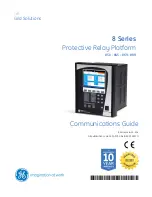
Functions
2.17 Automatic Reclosure Function (optional)
SIPROTEC, 7SD5, Manual
C53000-G1176-C169-5, Release date 02.2011
327
If the fault has been cleared (successful reclosure), line A - B is re-connected to the voltage at busbar A through
position I. Device II detects this voltage and also recloses after a short delay (to ensure a sufficient voltage mea-
suring time). The fault is cleared.
If the fault has not been cleared after reclosure at I (unsuccessful reclosure), the line will be disconnected again
in position I with the result that no healthy voltage is detected at location II so that the circuit breaker there does
not reclose.
In the case of multiple reclosure the sequence may be repeated several times following an unsuccessful reclo-
sure until one of the reclosure attempts is successful or a final trip takes place.
Figure 2-159
Example of adaptive dead time (ADT)
A, B, C
Busbars
I, II, III
Relay installation locations
X
Tripped circuit breakers
As is shown by the example, the adaptive dead time has the following advantages:
• The circuit breaker at position II is not reclosed if the fault persists and is not unnecessarily stressed as a
result.
• With non-selective tripping outside the protected zone by an overreaching time-graded protection, no further
reclosure cycles can be generated there because the fault current path via busbar B and position II remains
interrupted even after several reclosures.
• At position I overreach is allowed in the case of multiple reclosures and even in the event of final tripping
because the line remains open at position II and therefore no actual overreach can occur at I.
CLOSE-Command Transmission (Remote-CLOSE)
With close command transmission via the digital connection paths the dead times are only set at one line end.
The other line end (or line ends in lines with more than two ends) is set to „Adaptive Dead Time (ADT)“. The
latter merely responds to the close commands received from the transmitting end.
At the sending line end, the transmission of the close command is delayed until it is sure that the local reclosure
was successful. This means that the device waits whether a local pickup still occurs after reclosing. This delay
prevents unnecessary closing at the remote end on the one hand but also increases the time until reclosure
takes place there. This is not critical for a 1-pole interruption or in radial or meshed networks if no stability prob-
lems are expected under these conditions.










































